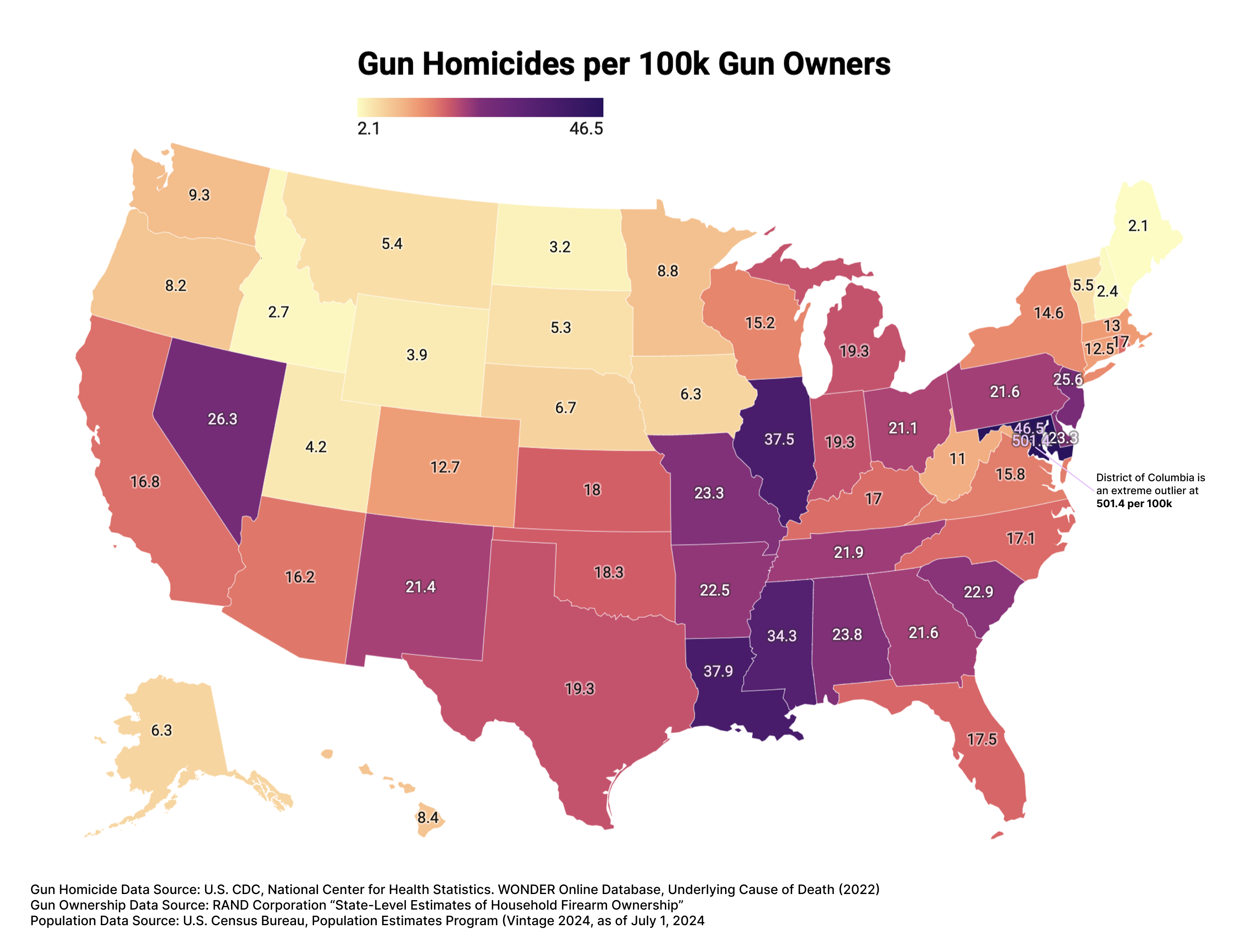Gun Homicides per 100k Gun Owners Map


Alex Cartwright
Senior Cartographer & GIS Specialist
Alex Cartwright is a renowned cartographer and geographic information systems specialist with over 15 years of experience in spatial analysis and data...
Geographic Analysis
What This Map Shows
The "Gun Homicides per 100k Gun Owners" map provides a stark visualization of gun-related homicides across various regions, contextualized by the number of gun owners in each area. This metric allows us to examine not just the raw number of homicides, but how they relate to gun ownership, offering a clearer picture of the relationship between firearms and violence. As we delve deeper into the topic, it’s essential to understand the broader implications of gun ownership and its correlation with homicide rates, as this is a critical issue affecting many communities.
Deep Dive into Gun Homicides and Ownership
Gun violence remains a contentious topic in societies around the world, particularly in the United States, where the right to bear arms is constitutionally protected. However, the relationship between gun ownership and homicide rates is complex and multifaceted. Research indicates that higher rates of gun ownership are often associated with elevated levels of firearm-related deaths. This phenomenon can be attributed to a variety of factors, including socio-economic conditions, gun laws, and cultural attitudes towards firearms.
Interestingly, studies have shown that states with more permissive gun laws tend to have higher rates of gun deaths. For instance, according to data from the Centers for Disease Control and Prevention (CDC), states like Alaska and Alabama, which have high rates of gun ownership, also report significant numbers of gun homicides. Conversely, states with stricter gun control measures, such as New York and California, generally experience lower rates of gun-related deaths.
Have you ever wondered why some states see such stark differences in homicide rates? A closer examination often reveals a combination of factors including urban versus rural settings, poverty rates, and access to mental health resources. For example, urban areas may experience higher gun violence due to concentrated poverty, gang activity, and social inequality, while rural areas may have higher gun ownership without the corresponding homicide rates due to different social dynamics.
Ultimately, the relationship between gun ownership and homicides is not merely about the numbers; it also encompasses issues of public safety, community health, and legislative effectiveness. It’s essential to consider how local laws, community programs, and educational initiatives can impact these rates. For example, states that invest in gun safety education and community outreach programs often see a reduction in gun violence, underscoring the importance of proactive measures.
Regional Analysis
The map illustrates significant regional variations in gun homicide rates per 100,000 gun owners. For instance, states in the South, such as Louisiana and Mississippi, often rank high in both gun ownership and homicide rates. In contrast, states in the Northeast, like Massachusetts and New Jersey, show lower rates of gun violence despite having considerable gun ownership.
What’s fascinating is how these patterns can shift over time. For example, states that have enacted comprehensive background checks and restrictions on assault weapons have seen declines in gun homicides. In 2019, Illinois reported a 15% reduction in gun homicides following the implementation of stricter gun laws. On the other hand, states that have relaxed gun control measures, such as permitless carry laws, have seen increases in gun-related deaths, further complicating the narrative.
It’s also worth noting the influence of urban areas within states. Cities like Chicago and Baltimore face challenges that rural areas do not, including gang violence and drug trafficking, which can skew overall statistics. In these urban settings, the concentration of gun violence can be alarming, prompting local authorities to explore solutions that address not just gun ownership, but also the underlying socio-economic issues.
Significance and Impact
Understanding the dynamics of gun homicides in relation to gun ownership is crucial for policymakers, law enforcement, and communities alike. This topic is not just a matter of statistics; it directly impacts public health and safety. As gun violence continues to rise in certain areas, the need for informed and effective policy responses becomes increasingly urgent.
Current trends indicate a rise in discussions surrounding gun reform, especially in the wake of high-profile incidents of gun violence. There’s a growing recognition that addressing gun homicides requires a multifaceted approach that includes mental health support, community engagement, and responsible gun ownership education. The future of gun policy will likely continue to evolve as communities seek to balance the rights of gun owners with the imperative of reducing violence.
As we analyze the data presented in the map, it serves not just as a reflection of our current landscape but as a call to action for stakeholders at every level. The conversation around gun violence is far from over, and understanding the geographical nuances is vital for developing sound strategies that prioritize safety and well-being in our communities.
Visualization Details
- Published
- September 30, 2025
- Views
- 50
Comments
Loading comments...